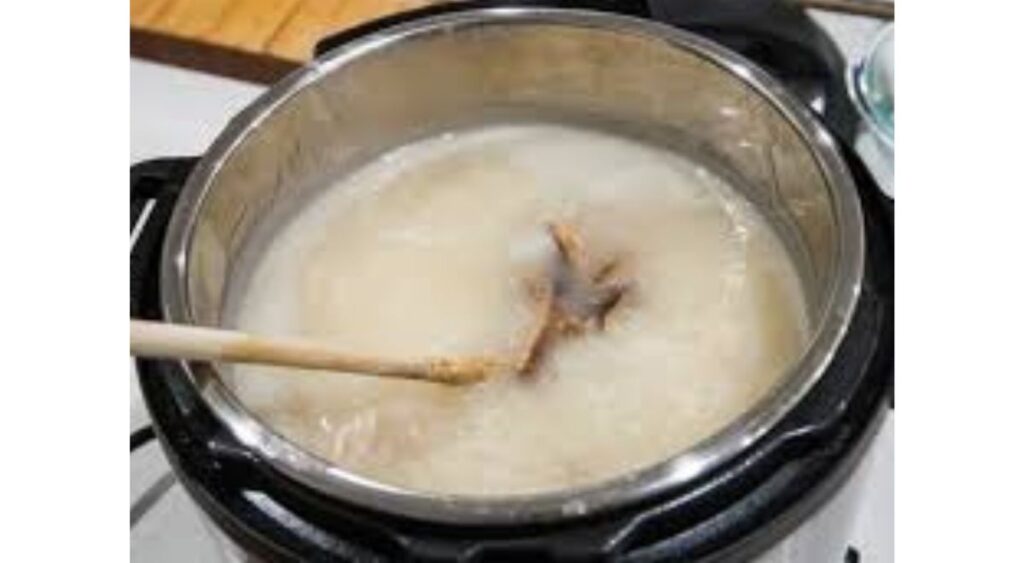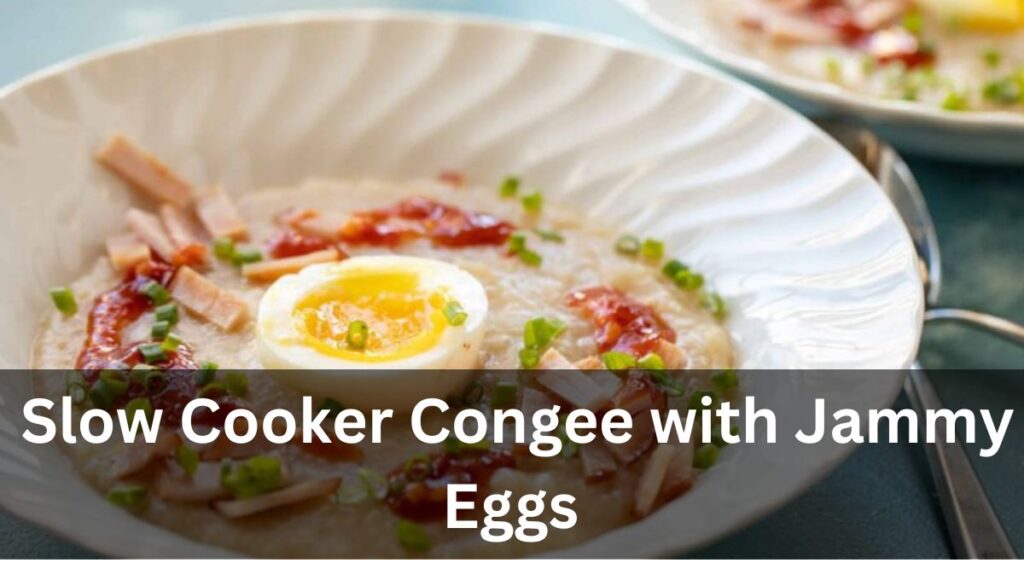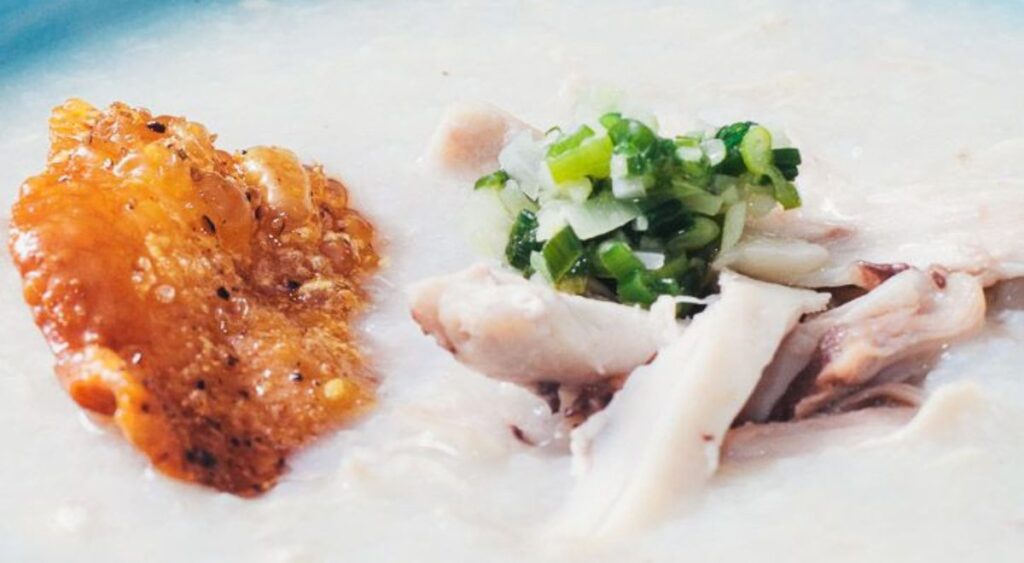Table of Contents
1. Introduction to Is Congee Good For Weight Loss
What Is Congee?
Congee, also known as rice porridge or rice gruel, is a traditional Asian dish that has been enjoyed for centuries. It is a simple yet versatile dish made by simmering rice in a large amount of water or broth until it reaches a creamy consistency. Congee is often flavored with various ingredients such as meats, vegetables, herbs, and spices, making it a customizable meal that can be enjoyed at any time of day.
Congee has its roots in Chinese cuisine but is also popular in other Asian countries like Japan, Korea, Thailand, and Vietnam. It is commonly eaten as a breakfast food or as a comforting meal during times of illness or recovery. However, its popularity has spread globally, with many people incorporating it into their regular diet due to its delicious taste and numerous health benefits.

Brief History and Cultural Significance
The origins of Congee can be traced back thousands of years to ancient China, where it was initially consumed as a way to stretch limited food supplies during times of famine or scarcity. Over time, Congee evolved from a simple staple food into a beloved dish enjoyed by people of all backgrounds.
In Chinese culture, Congee is often associated with nourishment, comfort, and healing. It is considered a soothing and easy-to-digest meal that is gentle on the stomach, making it suitable for both young children and the elderly. Congee is also believed to have medicinal properties, with certain ingredients added for their specific health benefits.
Beyond its culinary significance, Congee holds a special place in Asian households as a symbol of warmth, hospitality, and togetherness. Families gather around the table to share a bowl of Congee, exchanging stories and bonding over its comforting goodness.
In recent years, Congee has gained popularity in the West as more people become aware of its health benefits and versatility as a meal option. Whether enjoyed as a hearty breakfast, a satisfying lunch, or a light dinner, Congee continues to captivate taste buds and bring people together around the shared experience of good food.
2. Congee’s Role in Weight Loss
Weight Loss Breakfast Congee
Congee has gained recognition as a potential ally in the journey towards weight loss. Its popularity as a breakfast option stems from its ability to provide a satisfying and nutritious start to the day while supporting weight management goals.
Benefits of Breakfast Congee:
1. Satiety:
Congee’s creamy texture and high water content contribute to a feeling of fullness, helping to curb hunger and prevent overeating later in the day.
2. Low-Calorie Option:
Depending on the ingredients used, Congee can be prepared with minimal added fats and sugars, making it a low-calorie breakfast choice.
3. Nutrient Density:
Despite its simplicity, Congee can be packed with nutrients by incorporating lean proteins, fiber-rich vegetables, and healthy fats, providing essential vitamins and minerals to support overall health.
4. Slow Digestion:
The slow-cooking process of making Congee helps break down complex carbohydrates, resulting in a dish that is easier to digest and less likely to cause spikes in blood sugar levels, promoting stable energy throughout the morning.
5. Customization:
Congee is incredibly versatile, allowing for endless variations to suit individual taste preferences and dietary needs. Whether sweet or savory, vegetarian or meat-based, there’s a breakfast Congee recipe to suit every palate.
Lose Weight and Fight Inflammation with Congee
In addition to its potential to aid in weight loss, Congee may also offer anti-inflammatory benefits that can support overall health and well-being.
Inflammation and Weight Loss:
1. Gut Health:
Congee’s gentle nature makes it easy on the digestive system, promoting a healthy gut microbiome. Research suggests that a balanced gut flora may help reduce inflammation in the body, which is linked to weight gain and obesity.
2. Nutrient-Rich Ingredients:
By incorporating ingredients known for their anti-inflammatory properties, such as turmeric, ginger, garlic, and leafy greens, Congee can become a powerful tool in combating inflammation and promoting weight loss.
3. Balanced Macronutrients:
A well-balanced Congee meal that includes lean proteins, complex carbohydrates, and healthy fats can help regulate hormones involved in metabolism and appetite control, supporting weight loss efforts.
Congee – The Ultimate Bowl of Comfort
Beyond its potential benefits for weight loss, Congee is beloved for its comforting qualities that make it a satisfying and nourishing meal choice.
Comfort and Satisfaction:
1. Warmth and Nourishment:
Congee’s warm and soothing texture provides comfort on cold mornings or during times of illness, offering a sense of nourishment and well-being.
2. Versatility:
Whether enjoyed plain or loaded with toppings, Congee can be tailored to suit individual preferences and dietary restrictions, making it a versatile comfort food for everyone.
3. Cultural Significance:
Across Asian cultures, Congee holds a special place as a symbol of love, care, and hospitality. Sharing a bowl of Congee with loved ones fosters a sense of connection and community.
In conclusion, Congee’s role in weight loss extends beyond its simplicity and delicious taste. With its potential to promote satiety, support digestive health, and provide anti-inflammatory benefits, Congee emerges as a wholesome and satisfying meal option for those on a weight loss journey.
3. Health Benefits of Congee
Congee has long been revered not only for its delicious taste but also for its numerous health benefits. From supporting digestion to boosting immunity, Congee offers a wide array of advantages that make it a valuable addition to any diet.
Healing Properties of Congee
One of the most significant benefits of Congee is its ability to soothe and heal the body, making it a go-to meal during times of illness or recovery. Here’s how Congee’s healing properties can benefit your health:
1. Easy to Digest:
Congee’s soft and porridge-like consistency makes it easy on the digestive system, making it an ideal choice for those with sensitive stomachs or digestive issues.
2. Hydration:
With its high water content, Congee helps keep the body hydrated, which is essential for overall health and well-being, especially during illness when hydration is crucial.
3. Nutrient Absorption:
The slow-cooking process of making Congee helps break down nutrients in the ingredients, making them easier for the body to absorb, ensuring that you get the most out of your meal.
4. Calming Effects:
Congee’s gentle nature has a calming effect on the body, promoting relaxation and reducing stress, which can be beneficial for overall health and healing.
Congee as a Nutritious Meal Option
Despite its simplicity, Congee is surprisingly nutritious, offering a wide range of vitamins, minerals, and other essential nutrients. Here are some of the key nutrients found in Congee and their health benefits:
1. Protein:
Depending on the ingredients used, Congee can be a good source of protein, which is essential for building and repairing tissues, supporting muscle growth, and maintaining a healthy immune system.
2. Carbohydrates:
Congee provides a steady source of energy, thanks to its complex carbohydrates, which are slowly digested and absorbed by the body, preventing spikes in blood sugar levels and providing sustained energy throughout the day.
3. Fiber:
Fiber found in Congee, particularly if made with whole grains and vegetables, promotes healthy digestion, regulates bowel movements, and helps maintain a healthy weight by promoting feelings of fullness and reducing appetite.
4. Vitamins and Minerals:
Congee can be fortified with various vitamins and minerals, depending on the ingredients used. For example, adding vegetables like spinach, carrots, or mushrooms can increase the vitamin and mineral content of Congee, providing essential nutrients for overall health and well-being.
20 Congee Nutrition Facts
To further illustrate the nutritional value of Congee, here are 20 key nutrition facts that highlight its health benefits:
1. Low in Calories:
Congee can be prepared with minimal added fats and sugars, making it a low-calorie meal option.
2. High in Carbohydrates:
Congee provides a steady source of energy, thanks to its complex carbohydrates.
3. Good Source of Protein:
Depending on the ingredients used, Congee can be a good source of protein.
4. Rich in Fiber:
Congee promotes healthy digestion and helps maintain a healthy weight by providing fiber.
5. Contains Essential Vitamins and Minerals:
Congee can be fortified with various vitamins and minerals, depending on the ingredients used.
6. Low in Fat:
Congee can be prepared with minimal added fats, making it a low-fat meal option.
7. Gluten-Free Option:
Congee made with gluten-free grains like rice is suitable for those with gluten sensitivities or celiac disease.
8. Helps Boost Immunity:
The nutrients found in Congee support a healthy immune system, helping to fight off infections and illnesses.
9. Promotes Digestive Health:
Congee’s gentle nature and fiber content promote healthy digestion and regular bowel movements.
10. Can Aid in Weight Loss:
Congee’s high water and fiber content promote feelings of fullness and reduce appetite, making it a suitable option for weight loss.
11. Suitable for All Ages:
Congee is easy to digest and can be enjoyed by people of all ages, from infants to the elderly.
12. Hydrating Properties:
Congee’s high water content helps keep the body hydrated, promoting overall health and well-being.
13. Can Be Customized with Nutritious Toppings:
Congee can be customized with various toppings like vegetables, lean proteins, and healthy fats to boost its nutritional content.
14. Low Sodium Option:
Congee can be prepared with minimal added salt, making it a low-sodium meal option.
15. Easily Digestible:
Congee’s soft and porridge-like consistency makes it easy on the digestive system, ensuring optimal nutrient absorption.
16. Boosts Energy Levels:
Congee’s complex carbohydrates provide a steady source of energy, helping to fuel your day.
17. Helps Maintain Blood Sugar Levels:
Congee’s slow-digesting carbohydrates prevent spikes in blood sugar levels, making it suitable for those with diabetes or insulin resistance.
18. Supports Heart Health:
Congee’s low-fat and high-fiber content support heart health by lowering cholesterol levels and reducing the risk of heart disease.
19. Assists in Recovery After Illness:
Congee’s hydrating properties and nutrient content make it an ideal choice for recovery after illness or surgery.
20. Budget-Friendly Meal Option:
Congee is made with simple and affordable ingredients, making it a budget-friendly meal option for families.
4. Making Congee
Easy Steps to Make Congee
Making Congee at home is a straightforward process that requires minimal effort and ingredients. Here’s a simple recipe to guide you through the process:
Ingredients:
- 1 cup of rice (white rice, jasmine rice, or brown rice)
- 6 cups of water or broth (vegetable broth, chicken broth, or bone broth)
- Optional toppings: sliced green onions, minced ginger, cooked chicken or pork, tofu, mushrooms, vegetables, soy sauce, sesame oil, fried garlic, fried shallots, boiled eggs, or salted duck eggs.
Instructions:
1. Rinse the Rice:
Place the rice in a fine-mesh strainer and rinse it under cold water until the water runs clear. This helps remove excess starch and prevents the Congee from becoming too thick.
2. Cook the Rice:
In a large pot, combine the rinsed rice and water or broth. Bring the mixture to a boil over medium-high heat, then reduce the heat to low and simmer, uncovered, stirring occasionally to prevent sticking.
3. Simmer the Congee:
Allow the Congee to simmer gently for 1 to 1.5 hours, stirring occasionally, until the rice has broken down and the mixture has thickened to your desired consistency. If the Congee becomes too thick, you can add more water or broth as needed.
4. Add Toppings:
Once the Congee is cooked to your liking, remove it from the heat and stir in any desired toppings. Common toppings include sliced green onions, minced ginger, cooked chicken or pork, tofu, mushrooms, vegetables, soy sauce, sesame oil, fried garlic, fried shallots, boiled eggs, or salted duck eggs.
5. Serve and Enjoy:
Ladle the hot Congee into bowls and serve immediately. Garnish with additional toppings if desired, and enjoy it hot as a comforting meal any time of day.
Tips for Customization and Enjoyment
While the basic recipe for Congee is simple, there are countless ways to customize and enhance its flavor to suit your taste preferences. Here are some tips for making Congee your own:
1. Experiment with Grains:
While rice is the traditional base for Congee, you can experiment with other grains like barley, quinoa, or millet for added variety and nutrition.
2. Add Flavorful Broths:
Use different types of broth, such as vegetable broth, chicken broth, or bone broth, to infuse the Congee with rich flavor and nutrients.
3. Incorporate Seasonings:
Add minced garlic, ginger, or aromatics like star anise, cinnamon, or cloves to the cooking liquid for added depth of flavor.
4. Mix and Match Toppings:
Get creative with your toppings by mixing and matching different ingredients to create unique flavor combinations. Try adding fresh herbs, crunchy nuts, spicy chili oil, or tangy pickles for added texture and taste.
5. Adjust Consistency:
Customize the thickness of your Congee by adjusting the ratio of rice to water or broth. For a thicker Congee, use less liquid, and for a thinner consistency, use more liquid.
6. Garnish with Fresh Ingredients:
Brighten up your Congee with fresh garnishes like chopped cilantro, sliced scallions, or a squeeze of lime juice for added freshness and flavor.
By following these tips and experimenting with different ingredients and flavor combinations, you can create a delicious and comforting bowl of Congee that’s tailored to your taste preferences and dietary needs. Whether enjoyed as a hearty breakfast, a satisfying lunch, or a light dinner, Congee is sure to warm your soul and nourish your body with its comforting goodness.
5. Congee Recipes
Congee’s versatility as a meal extends beyond its basic recipe, with countless variations and adaptations to suit different tastes and dietary preferences. From savory to sweet, vegetarian to meat-based, here are some delicious Congee recipes to inspire your culinary creativity:
1. Brown Rice Congee with Chicken, Edamame, and Crispy Mushrooms

Ingredients:
- 1 cup brown rice
- 6 cups chicken broth
- 1 cup cooked chicken, shredded
- 1 cup edamame, shelled
- 1 cup mushrooms, sliced
- 2 tablespoons vegetable oil
- Salt and pepper to taste
- Optional toppings: sliced green onions, minced ginger, soy sauce, sesame oil
Instructions:
- Rinse the brown rice under cold water until the water runs clear.
- In a large pot, combine the rinsed rice and chicken broth. Bring to a boil over medium-high heat, then reduce the heat to low and simmer, uncovered, for 1 to 1.5 hours, stirring occasionally.
- While the Congee is simmering, heat the vegetable oil in a skillet over medium heat. Add the sliced mushrooms and cook until crispy and golden brown, about 5-7 minutes. Season with salt and pepper to taste.
- Once the Congee has reached your desired consistency, stir in the cooked chicken and edamame. Cook for an additional 5-10 minutes until heated through.
- Ladle the Congee into bowls and top with the crispy mushrooms. Garnish with sliced green onions, minced ginger, soy sauce, and sesame oil if desired. Serve hot and enjoy!
2. Instant Pot Chicken Congee

Ingredients:
- 1 cup white rice
- 6 cups chicken broth
- 1 pound boneless, skinless chicken thighs
- 1-inch piece of ginger, peeled and sliced
- Salt and pepper to taste
- Optional toppings: sliced green onions, cilantro, fried garlic, chili oil
Instructions:
- Rinse the white rice under cold water until the water runs clear.
- In the Instant Pot, combine the rinsed rice, chicken broth, chicken thighs, and sliced ginger. Season with salt and pepper to taste.
- Close the lid and set the Instant Pot to “Manual” mode for 20 minutes.
- Once the cooking cycle is complete, allow the pressure to release naturally for 10 minutes, then carefully release any remaining pressure manually.
- Open the lid and use a fork to shred the chicken thighs directly in the pot. Stir the Congee to combine.
- Ladle the Congee into bowls and top with sliced green onions, cilantro, fried garlic, and a drizzle of chili oil if desired. Serve hot and enjoy!
3. Vegetarian Congee

Ingredients:
- 1 cup jasmine rice
- 6 cups vegetable broth
- 1 cup tofu, cubed
- 1 cup mixed vegetables (carrots, peas, corn)
- 2 tablespoons soy sauce
- 1 tablespoon sesame oil
- Optional toppings: sliced green onions, toasted sesame seeds, nori strips
Instructions:
- Rinse the jasmine rice under cold water until the water runs clear.
- In a large pot, combine the rinsed rice and vegetable broth. Bring to a boil over medium-high heat, then reduce the heat to low and simmer, uncovered, for 1 to 1.5 hours, stirring occasionally.
- Stir in the cubed tofu and mixed vegetables. Cook for an additional 10-15 minutes until heated through.
- Season the Congee with soy sauce and sesame oil, adjusting to taste.
- Ladle the Congee into bowls and top with sliced green onions, toasted sesame seeds, and nori strips if desired. Serve hot and enjoy!
4. Slow Cooker Congee with Jammy Eggs

Ingredients:
- 1 cup sushi rice
- 6 cups chicken broth
- 4 eggs
- 1-inch piece of ginger, peeled and sliced
- Salt and pepper to taste
- Optional toppings: sliced scallions, sesame oil, chili flakes
Instructions:
- Rinse the sushi rice under cold water until the water runs clear.
- In a slow cooker, combine the rinsed rice, chicken broth, and sliced ginger. Season with salt and pepper to taste.
- Cover and cook on low for 6-8 hours or on high for 3-4 hours, until the rice is cooked and the Congee is thick and creamy.
- About 30 minutes before serving, carefully crack the eggs into the slow cooker, making sure they are submerged in the Congee. Cover and continue cooking until the whites are set but the yolks are still runny, about 30 minutes.
- Ladle the Congee into bowls and top each serving with a jammy egg. Garnish with sliced scallions, a drizzle of sesame oil, and chili flakes if desired. Serve hot and enjoy!
5. Congee with Crispy Chicken Skin

Ingredients:
- 1 cup jasmine rice
- 6 cups chicken broth
- 4 chicken thighs, skin-on
- 2 tablespoons vegetable oil
- Salt and pepper to taste
- Optional toppings: sliced green onions, fried shallots, crispy garlic, chili oil
Instructions:
- Rinse the jasmine rice under cold water until the water runs clear.
- In a large pot, combine the rinsed rice and chicken broth. Bring to a boil over medium-high heat, then reduce the heat to low and simmer, uncovered, for 1 to 1.5 hours, stirring occasionally.
- While the Congee is simmering, preheat the oven to 400°F (200°C). Place the chicken thighs on a baking sheet lined with parchment paper and season generously with salt and pepper. Roast in the oven for 25-30 minutes until the skin is crispy and golden brown.
- Once the Congee has reached your desired consistency, ladle it into bowls. Top each serving with a crispy chicken thigh, skin-side up.
- Garnish the Congee with sliced green onions, fried shallots, crispy garlic, and a drizzle of chili oil if desired. Serve hot and enjoy!
These Congee recipes showcase the dish’s versatility and adaptability, offering a wide range of flavors and ingredients to suit every taste preference and dietary need. Whether you prefer a classic chicken Congee or a vegetarian variation loaded with colorful vegetables, there’s a recipe here to satisfy your cravings and inspire your culinary adventures. Enjoy the comforting goodness of Congee any time of day with these delicious and nutritious recipes!
6. Addressing Health Concerns
Congee, despite its many benefits, may not be suitable for everyone in every situation. Here, we’ll explore some common health concerns related to Congee and offer guidance on when to exercise caution.
When to Avoid Eating Congee
1. Digestive Issues:
While Congee is generally easy to digest, some individuals with sensitive digestive systems may experience discomfort or bloating after consuming it. If you have a history of digestive issues such as irritable bowel syndrome (IBS) or gastroesophageal reflux disease (GERD), it’s essential to listen to your body and avoid foods that exacerbate your symptoms.
2. High Carbohydrate Content:
Congee, being primarily made of rice, is high in carbohydrates. While complex carbohydrates provide sustained energy, individuals following a low-carbohydrate or ketogenic diet may need to limit their intake of Congee to maintain their dietary goals.
3. Food Allergies or Sensitivities:
If you have food allergies or sensitivities, it’s essential to carefully select ingredients and toppings for your Congee to avoid potential allergens. Common allergens such as gluten, soy, dairy, and shellfish may be present in certain Congee recipes or toppings, so always read labels and ask about ingredients when dining out.
Is Congee Suitable as Sick Food?
Congee has long been regarded as a soothing and nourishing meal for individuals recovering from illness or experiencing digestive discomfort. Here’s why Congee is often recommended as sick food:
1. Gentle on the Stomach:
Congee’s soft and easily digestible texture makes it an excellent choice for individuals with upset stomachs, nausea, or other gastrointestinal issues. It provides nourishment without putting additional strain on the digestive system.
2. Hydrating Properties:
Congee’s high water content helps keep the body hydrated, which is essential for recovery from illness, especially if accompanied by fever, vomiting, or diarrhea.
3. Nutrient-Rich Ingredients:
Congee can be customized with nutrient-rich ingredients such as lean proteins, vegetables, and herbs, providing essential vitamins, minerals, and antioxidants to support immune function and overall healing.
However, it’s essential to note that individual tolerances may vary, and not all sick individuals may find relief from consuming Congee. If you’re feeling unwell, it’s best to consult with a healthcare professional for personalized dietary advice tailored to your specific needs and symptoms.
In summary, while Congee offers many health benefits and is often recommended as a comforting and nourishing meal, it may not be suitable for everyone in every situation. Individuals with digestive issues, food allergies, or specific dietary goals should exercise caution and consider their individual needs when incorporating Congee into their diet. As always, it’s essential to listen to your body and seek guidance from a healthcare professional if you have any concerns or questions about your diet and health.
7. Conclusion for Is Congee Good For Weight Loss
In conclusion, Congee emerges as a versatile and nutritious meal option that offers numerous health benefits and culinary delights. From its origins as a simple rice porridge to its evolution into a beloved comfort food enjoyed by people around the world, Congee has stood the test of time as a nourishing and satisfying dish.
Throughout this article, we’ve explored the various aspects of Congee, from its humble beginnings to its role in supporting weight loss and overall health. We’ve delved into its healing properties, highlighted its nutrient-rich ingredients, and shared delicious recipes to inspire your culinary adventures.
Congee’s ability to provide comfort, nourishment, and sustenance makes it a valuable addition to any diet, whether you’re looking to lose weight, support digestion, or simply enjoy a delicious and satisfying meal. Its versatility allows for endless variations and adaptations to suit different tastes, dietary preferences, and cultural traditions.
However, it’s essential to approach Congee with awareness and mindfulness, especially for individuals with specific health concerns or dietary restrictions. While Congee offers many benefits, it may not be suitable for everyone in every situation. It’s essential to listen to your body, consider your individual needs, and make informed choices about your diet and health.
Ultimately, whether enjoyed as a comforting breakfast, a hearty lunch, or a light dinner, Congee embodies the essence of nourishment, warmth, and togetherness. So, next time you’re in need of a comforting and nutritious meal, why not give Congee a try? With its delicious taste and health-promoting properties, Congee is sure to warm your soul and nourish your body with its comforting goodness.



Pingback: Are Peanut Butter Pretzels Good For Weight Loss in 2024